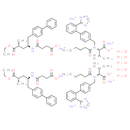Description
LCZ696 is a potent ARNi inhibitor and an investigational drug to treat heart failure. Chemically, LCZ696 is a mixture of valsartan and sacubitril in a 1:1 molar ratio. As of 2014 it is being developed by Novartis. LCZ696 is co-crystallized valsartan and sacubitril, in a one-to-one molar ratio. According to Sci-Finder database, LCZ696 has a formula as (valsartan)(sacubitril)(3Sodium)(5/2 hydrate), or (2 valsartan)(2 sacubitril) (6 Sodium)(5 hydrate), which has results C96H120N12Na6O21. Molecular Weight: 1915.99 . However, according to wikipedia, One LCZ696 complex consists of 6 valsartan anions, 6 sacubitril anions, 18 sodium cations, and 15 molecules of water, resulting in the molecular formula C288H330N36Na18O48·15H2O and a molecular mass of 5748.03 g/mol. The substance is a white powder consisting of thin hexagonal plates. It is stable in solid form as well as in aqueous (watery) solution with a pH of 5 to 7, and has a melting point of about 138 °C (280 °F).(http://en.wikipedia.org/wiki/Valsartan/sacubitril)
Product information
CAS Number: 936623-90-4
Molecular Weight: 957.99
Formula: C96H120N12Na6O21
Synonym:
Valsartan/sacubitril
LCZ-696
Chemical Name: (2S)-3-methyl-2-(N-{[2'-(1H-1,2,3,4-tetrazol-5-yl)-[1,1'-biphenyl]-4-yl]methyl}pentanamido)butanoic acid 3-{[(2S,4R)-1-{[1,1'-biphenyl]-4-yl}-5-ethoxy-4-methyl-5-oxopentan-2-yl]carbamoyl}propanoic acid hydrate sodium hydride
Smiles: O.O.O.O.O.[Na+].[Na+].[Na+].[Na+].[Na+].[Na+].CC(C)[C@@H](C([O-])=O)N(CC1C=CC(=CC=1)C1=CC=CC=C1C1[N-]N=NN=1)C(=O)CCCC.CC(C)[C@H](C([O-])=O)N(CC1C=CC(=CC=1)C1=CC=CC=C1C1[N-]N=NN=1)C(=O)CCCC.C[C@H](C[C@@H](CC1C=CC(=CC=1)C1C=CC=CC=1)NC(=O)CCC([O-])=O)C(=O)OCC.C[C@@H](C[C@H](CC1C=CC(=CC=1)C1C=CC=CC=1)NC(=O)CCC([O-])=O)C(=O)OCC
InChiKey: ZASXKEGREHRXDL-QFELSHFRSA-H
InChi: InChI=1S/2C24H29N5O3.2C24H29NO5.6Na.5H2O/c2*1-4-5-10-21(30)29(22(16(2)3)24(31)32)15-17-11-13-18(14-12-17)19-8-6-7-9-20(19)23-25-27-28-26-23;2*1-3-30-24(29)17(2)15-21(25-22(26)13-14-23(27)28)16-18-9-11-20(12-10-18)19-7-5-4-6-8-19;;;;;;;;;;;/h2*6-9,11-14,16,22H,4-5,10,15H2,1-3H3,(H2,25,26,27,28,31,32);2*4-12,17,21H,3,13-16H2,1-2H3,(H,25,26)(H,27,28);;;;;;;5*1H2/q;;;;6*+1;;;;;/p-6/t2*22-;2*17-,21+;;;;;;;;;;;/m1010.........../s1
Technical Data
Appearance: Solid Power
Purity: ≥98% (or refer to the Certificate of Analysis)
Solubility: Soluble in DMSO (100mg/mL) and water (50mg/mL)
Shipping Condition: Shipped under ambient temperature as non-hazardous chemical or refer to Certificate of Analysis
Storage Condition: Dry, dark and -20 oC for 1 year or refer to the Certificate of Analysis.
Shelf Life: ≥12 months if stored properly.
Stock Solution Storage: 0 - 4 oC for 1 month or refer to the Certificate of Analysis.
Drug Formulation: To be determined
HS Tariff Code: 382200
How to use
In Vitro:
By utilizing the LPS-induced HUVECs injury model, this study shows that LCZ696 has the protective capacity to suppress LPS-induced inflammation and ROS production in endothelial cells. Findings reveal that LCZ696 inhibits all the tested pro-inflammatory cytokines and chemokines’ induction, including IL-1α, TNF-β, IL-6, CXCL1, and MCP-1. These mediators are critical factors in the inflammatory processes. Currently, endothelial cells have been recognized as an important source of multifunctional cytokine production, and endothelial-derived cytokines are known to be involved in hematopoiesis, immune response, coagulation, and other processes. As a result, LCZ696 treatment significantly reduces LPS-induced intracellular ROS and MDA levels, which are lipid peroxidation products in endothelial cells.
In Vivo:
Subsequently, it was also found that LCZ696 could inhibit cardiac hypertrophy, fibrosis and apoptosis induced by Ang II in mouse model with PAH (pregnancy-associated cardiomyopathy). Moreover, LCZ696 could inhibit the expression of ANP, βMHC and TIMP2, collagen I, collagen III and TGF-β. Ang II, a vasopressor hormone, functions in maintaining normal blood pressure and pathogenesis of cardiovascular diseases, and its overproduction forces the occurrence of hypertension in late pregnancy of mice with PAH. A previous study has demonstrated the ability of Ang II to induce high ANP and βMHC levels in cardiomyocytes in cardiac hypertrophy. TIMP2 and TIMP3 are regulators of cardiac remodeling, hypertrophy, and fibrosis in heart disease and can be induced by Ang II. Ang II was also able to induce collagen gene transcription with the involvement of the TGF-β superfamily in cardiac fibroblasts.
References:
- Fabris E, Merlo M, Rapezzi C, Ferrari R, Metra M, Frigerio M, Sinagra G. Sacubitril/Valsartan: Updates and Clinical Evidence for a Disease-Modifying Approach. Drugs. 2019 Sep;79(14):1543-1556.
- Dewan P, Docherty KF, McMurray JJV. Sacubitril/Valsartan in Asian Patients with Heart Failure with Reduced Ejection Fraction. Korean Circ J. 2019 Jun;49(6):469-484.
- Fonseca C, Brito D, Ferreira J, Franco F, Morais J, Silva Cardoso J; Experts opinion, endorsed by the Working Group on Heart Failure of the Portuguese Society of cardiology. Sacubitril/valsartan: A practical guide. Rev Port Cardiol. 2019 May;38(5):309-313.
Products are for research use only. Not for human use.
Payment & Security
Your payment information is processed securely. We do not store credit card details nor have access to your credit card information.


